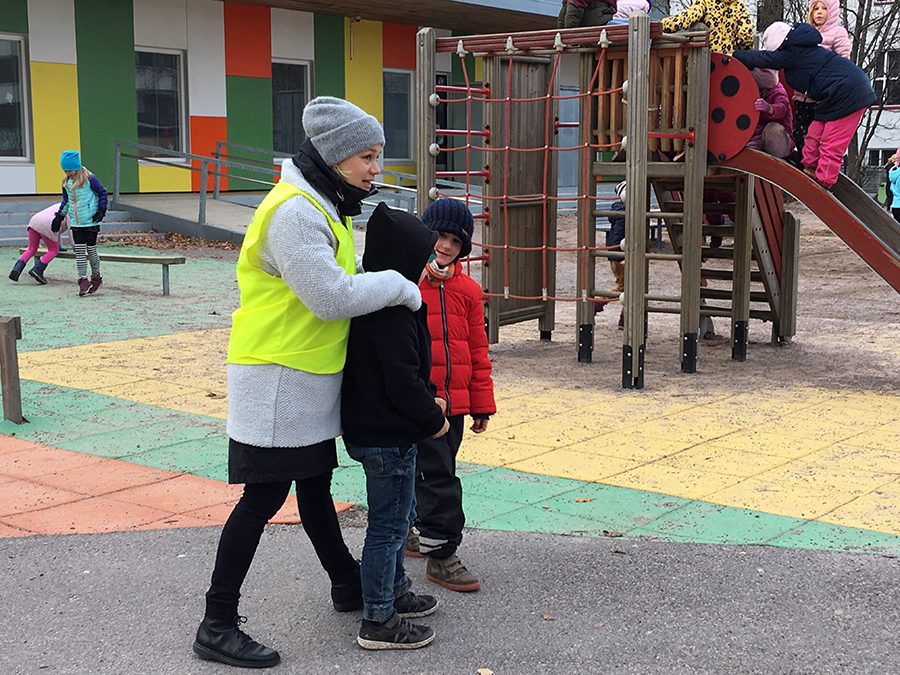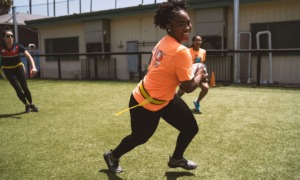
Photos by Stell Simonton
Students take a play break four or five times a day at this school in Helsinki that serves preschoolers to sixth-graders.
HELSINKI, Finland — The birch trees were still golden on a crisp autumn day as children played outside Drumsö Primary School.
They bounced a basketball, chased one another and clambered on a play structure — activities that appeared unremarkable.
And yet their experience is different than it would be in most American schools and many after-school programs. At Drumsö, vigorous physical activity is spread throughout the day, incorporated into class time and introduced by older children to younger ones.
It’s a model that could give American schools and after-school programs some ideas.
The school, with almost 340 students from preschool to sixth grade, is trying to “change the culture,” said sixth-grade teacher Johanna Berlin.
The sedentary life
Over the past decade, researchers have noted a drop in the level of physical activity among kids worldwide — as well as the problem of childhood obesity. Decreased physical activity is linked to conditions such as cardiovascular disease, diabetes and cancer, according to the World Health Organization (WHO).
In the United States, fewer than one-fourth of children and youth get 60 minutes of activity per day as recommended by WHO, according to a 2018 United States Report Card on Physical Activity for Children and Youth. And as kids grow older, time spent in physical activity decreases.
Drumsö Primary School is countering the trend.
Its students take four or five activity breaks during the day. Each can be as long as 20 minutes. Older students called “movers” are trained to lead younger children in playground games. For example, sixth graders Ida and Hilda demonstrated how they play games like “bubble tag” with younger kids.
Teachers also incorporate physical activity into lessons. When students created a history timeline, they pasted it on the stairway wall, climbing up and down stairs to work on it.

Two sixth-grade girls gather ribbons strewn on the floor and use the letters on each ribbon to make words and sentences. The ribbons can also be used in a game of tag.
“During math lesson, they do one page and then go out in the corridor and do some exercise,” Berlin said. “It’s easier for them to learn if they’re integrating movement.”
For young students, “lily pads” on the hallway floor name the days of the week and encourage hopping from one to the next.
A former United Kingdom teacher, Bryn Llewellyn, who develops and sells active learning materials, led a game at Drumsö to demonstrate. Students ran to pick up yellow and red ribbons strewn on the floor. They then made words and sentences with the letters on the ribbons.
Drumsö is part of a national effort in most of Finland’s comprehensive schools to increase physical activity. It has three main goals:
- more movement and less sitting
- improved learning
- increased student participation.
Researchers keep tabs
Recent research in Finland indicates that physical activity during the school day correlates with greater student engagement, attention and academic performance. When teachers were surveyed, most said the greater activity made the school day more enjoyable.
A global network of researchers, health professionals and others formed the Active Healthy Kids Global Alliance to promote greater physical activity. The organization held its first summit in 2014, and by 2018, members were reporting data from 49 countries.
The alliance saw Finland as a leader in the effort. Finland’s 2018 report card found 27% to 33% of its children and youth met the standard of 60 minutes of activity per day.
The need for greater physical activity does not dominate the discussion in U.S. education circles. But both schools and after-school programs, which are set up for the benefit of young people, could look at the data and decide how to promote youth well-being. The hours after school could clearly be a time to prioritize physical activity.































